
|   |

|   |
Kaleidoscope of enchanting dance performances - Satish Suri e-mail: satishism@yahoo.co.in Photos: Prof. K.S. Krishnamurthy November 17, 2024 Body and Breath: Our Sacred Spaces The double bill of Bharatanatyam performances, on November 3rd at the Bangalore International Centre was an exciting and thought provoking event. The fusion of tradition with innovation often leads to a dynamic and enriching experience. 'Body as a Temple' by Shreema Upadhayaya and 'Breath' by Deepali Salil and Sayani Chakraborty offered unique perspectives on Bharatanatyam, blending the classical form with modern creative expressions. The idea that the body can be a temple and that it houses the divine potential within it aligns with numerous spiritual traditions. The universal exploration of the body's energies leading to the illumination of the devotee is a deeply compelling theme. It suggests a journey of physical and spiritual toward enlightenment, where the human body, through its energies and movements, serves as a conduit to higher realms of consciousness or divine understanding. 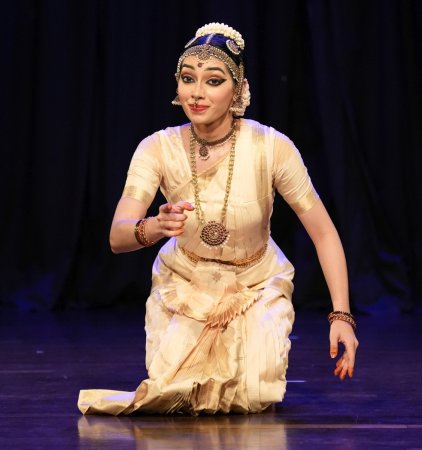 Shreema Upadhyaya Shreema Upadhyaya's solo performance 'Degula' was a profound exploration of the human body as a temple, to illustrate the sacredness of the body as a vessel for the soul. This captivating piece approached its subject matter from a universal perspective, emphasizing the body's energies and their potential to lead to spiritual illumination. The jatiswaram in raga Todi, a composition by Swati Tirunal, provided a rich backdrop for the nuanced exposition of themes in Shreema's performance Through intricate movements, Shreema depicted the transformative journey of a devotee, transitioning from a grounded, earthly existence to a state of divine union. Each movement was imbued with intention and grace. The interplay between the music and her choreography highlighted the nuances of the theme. The jatiswaram's melodic phrases echoed the emotional journey of the devotee, enhancing the audience's understanding of the performance's spiritual narrative. The rhythmic patterns of the jatiswaram also allowed for moments of improvisation, where Shreema could infuse her interpretation into the dance. This dynamic interaction between the dancer and the music created a vibrant dialogue, further enriching the performance and inviting the audience to engage with the themes on a deeper level. This journey symbolized the awakening process and the quest to reach the Godhead, encapsulating the essence of spiritual aspiration. The performance served as a powerful metaphor for the alignment of physical and spiritual energies, showcasing how dance can be a vehicle for pursuing higher consciousness. She concluded with a vachana of the saint poet Basavanna which highlighted the profound confluence of all consciousness at Kudala Sangama. This sacred place symbolizes the merging of individual souls into the divine, reflecting the unity and interconnectedness of all existence. It's a powerful reminder of the spiritual journey towards realizing our oneness with the divine. 'Degula' invited the audience to reflect on their journeys, encouraging a deeper understanding of the sacred interplay between body, mind, and spirit. In this way, Shreema not only presented a stunning visual spectacle but also offered a meaningful commentary on the spiritual dimensions of human existence. The aharya added grace and depth to the performance, ensuring that every aspect was aligned with the central theme of spiritual awakening. The synergy between the aharya, the dance, and the music worked together to create an aesthetic experience, deepening the impact of the presentation. 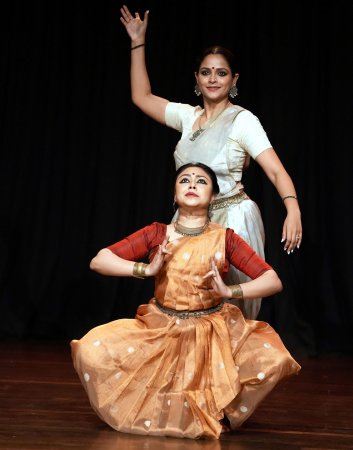 Deepali Salil and Sayani Chakraborty The second performance for the day was 'Breath' by Deepali Salil and Sayani Chakraborty. What a beautifully articulated description of 'Breath' as a performance! Deepali Salil and Sayani Chakraborty deeply intertwined the physical act of dance with the philosophical and spiritual essence of breath. The idea that breath is not just a biological function but also a conduit for emotional well-being and spiritual awakening is so powerful, and it's clear how this theme aligns with the principles of Bharatanatyam, where the body becomes a vessel for both expression and transcendence. The merging of 'Shiva' into the dancer, where two dancers become one, was especially evocative. Shiva's Ananda Tandava is often depicted as a cosmic dance, symbolizing the rhythm of the universe - creation, preservation, and destruction. By embodying Shiva in this piece, the dancers, tapped into a deep connection to the cosmos, where the individual self merges with the universal, suggesting a dance that transcends physical boundaries and time. The choreography visually conveyed this merging of self and divinity, and how the breath served as the guiding force. The "incessant breath" was like a metaphor for the constant flow of life itself - never ceasing, always present, always shaping our experience of the world. The enactment by Deepali Salil and Sayani Chakraborty beautifully illustrated the profound connection between breath and movement, showcasing how the dancer derives energy from the very essence of life within. Their performance symbolized the union of two dancers - herself and Shiva, the cosmic dancer, embodying the intricate relationship between the individual and the divine. As they transitioned into the conclusion, they presented sahitya sourced from the 'Tirumandiram,' a revered composition by the Tamil Siddhar Tirumular, an ardent devotee of Shiva. This text, comprised of nine chapters, offers a vivid portrayal of Nataraja, the cosmic form of Shiva, emphasizing the dance of creation, preservation, and destruction. This segment of the performance served as a tribute to their acharya, Rama Vaidyanathan, and was excerpted from her piece titled 'Swasam,' with valuable inputs provided by Sridhar Vasudevan. The dancers' movements echoed the themes of the Tirumandiram, reflecting the deep spiritual significance of Shiva's dance, merging artistry with devotion. Through their expressive gestures, intricate footwork, and synchronized breathing, the performance became a meditation on the divine, celebrating the transcendental nature of dance as a means to connect with the cosmic energy that flows through all beings. Their portrayal left the audience in awe, evoking a sense of reverence for the dance and its spiritual roots. Nandanam Art Foundation Leela - A Festival of Arts had a vibrant launch with its Youth First Edition, showcasing three solo Bharatanatyam performances at the Seva Sadan on November 7th. This inaugural event highlighted the talents of emerging artistes, providing them a platform to express their artistry. Each soloist brought a unique interpretation to the stage, embodying the essence of Bharatanatyam while exploring contemporary themes and personal narratives. "Gaana Trimurti Vandana" was a homage to the musical Trinity - Muthuswamy Dikshitar, Tyagaraja and Shyama Sastri. 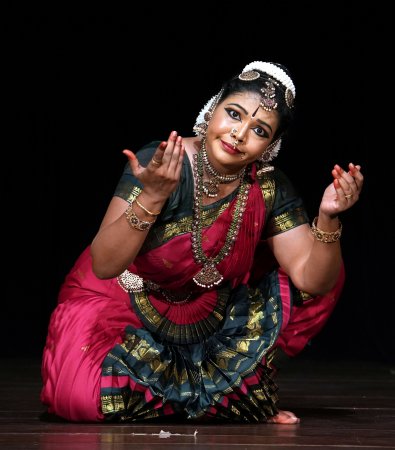 Deepika Govindaraju Deepika Govindaraju provided a bright start with her performance of "Vatapi Ganapatim," a renowned composition by Muthuswamy Dikshitar. The choreography, crafted by her guru Mithun Shyam, infused the piece with a strong devotional appeal, effectively capturing the essence of the composition. The performance showcased crisp and attractive swara, which dominated the portrayal, allowing Deepika to express the intricate nuances of the raga. Deepika continued with "Jagadanandakaraka," the first Pancharatna kriti composed by Tyagaraja in raga Nattai. This piece is celebrated for its rich devotional content and intricate musical structure. In her interpretation, Deepika explored various incidents from the Ramayana, bringing to life the narrative through her expressive movements and emotive storytelling. The choreography highlighted key moments and characters from the epic, allowing the audience to connect with the profound themes of devotion and righteousness embodied in the text. Deepika's performance not only showcased her technical prowess but also her ability to convey deep emotional resonance, making the ancient stories accessible to contemporary audiences. Deepika Govindaraju concluded her impressive performance with "Sarojadalanetri," a beautiful composition by Shyama Sastri in raga Shankarabharanam, dedicated to Goddess Meenakshi. This piece is renowned for its lyrical beauty and devotional fervour, celebrating the grace and power of the goddess. Executed with skill and panache, Deepika's portrayal of "Sarojadalanetri" showcased her technical mastery and deep emotional connection to the music. Her movements reflected the elegance and strength of Goddess Meenakshi. The music ensemble for Deepika Govindaraju's performance was led by Harshita Vidya on vocals, Mithun Shyam on nattuvangam, Dhanush Natampalli on mridangam, and Karthik Sattavalli on flute. The combination of these talented musicians created a rich auditory backdrop that complemented Deepika's dance, allowing her to fully express the emotional and spiritual nuances of each piece. 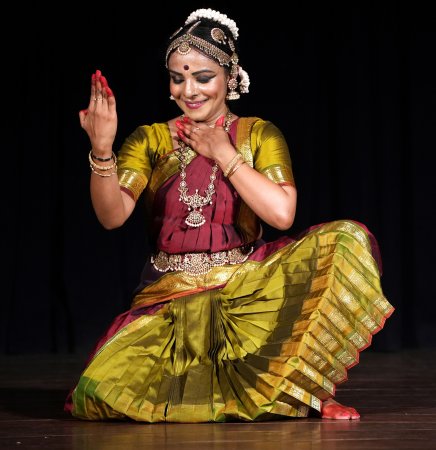 Sandhya Udupa The second artiste for the evening was Sandhya Udupa, a disciple of Indira Kadambi. Sandhya Udupa's exposition of the varnam "Swamiye Karitare," a composition by Geeta Seetharam in raga Amrithavarshini and vocalized by T.V. Ramprasadh, on a recorded track, captivated the audience with its delicate and graceful movements. Each idea within the varnam was explored in depth. Her exposition was an embodiment of grace, enhanced by the vibrant jathis choreographed by her Guru, Indira Kadambi. The intricate footwork and expressive hand gestures brought the narrative to life, reflecting the inner turmoil and longing of the Nayika. In this enchanting portrayal, the lovelorn Nayika implores her Sakhi to go and fetch her beloved Lord Venugopala, the wondrous one who mesmerizes all with his flute playing. She describes the glory and achievements of Venugopala. As she senses a hint of hesitancy from the Sakhi, Sandhya skillfully coaxes her, even offering the inducement of jewellery to tempt her into fetching her Lord. This interplay between the characters was performed with a mix of urgency and tenderness, allowing the audience to feel the Nayika's yearning and desperation. The footwork articulated the rhythmic sequences with remarkable clarity, demonstrating her mastery of the intricate patterns that define the dance form. Each step was executed with finesse, enhancing the overall aesthetic of the performance and allowing the audience to appreciate the rhythmic complexity of the piece. The concluding piece showcased the dancer's emotive prowess, with Sandhya Udupa delivering a compelling portrayal as a woman scorned by her love interest, Venkateshwara. Her interpretation of the javali "Vagalaadi Bodhanalaku," set in raga Behag and rupaka talam, composed by Tirupati Narayanaswami and originally choreographed by Kalanidhi Narayanan, was filled with intensity and depth. Sandhya's performance captured the raw emotions of anger and sarcasm as she navigated the complexities of her character's heartbreak. Her expressive movements and facial nuances conveyed the pain of betrayal, while the clever use of humour added a delightful contrast. As she tried to convince Venkateshwara of the other woman's questionable character, she infused the narrative with wit, describing the rival's antics - how she entertained numerous men simultaneously, cleverly hiding them under the bed or behind furniture. This not only showcased Sandhya's versatility as a dancer but also highlighted her ability to engage the audience with a blend of drama and comedy. Through her execution, Sandhya left the audience both entertained and moved, a testament to her talent. 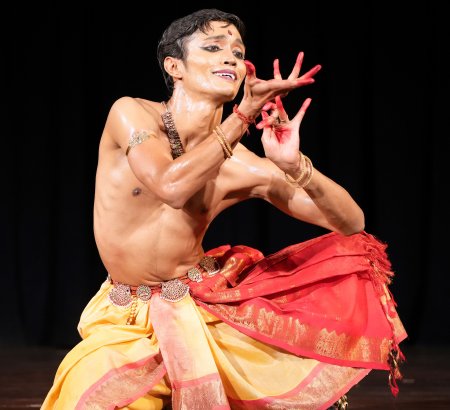 Pritam Das The final presentation was delivered by the talented Pritam Das, a disciple of Rama Vaidyanathan, who showcased the varnam "Mohalahiri konden Sami," a composition in raga Todi by Sivanandam of the Tanjore Quartet. In a moment of deep longing and emotional intensity, the Nayika expresses her heart's turmoil: "My heart overflows with passion. Your presence is everywhere - in the delicate petals of the lotus flower, in the resonant chime of the temple bell, and the soothing fragrance of sandal paste. I yearn for your gentle touch and your comforting words. Please, do not be indifferent to my plight. You hold the key to my heart. Won't you enfold me in your love, wrapping me in the warmth of your embrace? Kamadeva, the god of love, torments me relentlessly, igniting flames of desire that threaten to consume me. I am drowning in this passion, lost in a sea of yearning. Help me, Rajagopala. Guide me back to the shores of your affection, where I can find solace in your presence once more." Pritam's performance was characterized by sheer audacity and brilliance, captivating the audience from the very first movement. His graphic body language and brilliant flexes defined a kinetic movement profile that was both dynamic and expressive. The adavus added vibrancy to his performance, creating a lively atmosphere. The jathis, originally composed by the late Yamini Krishnamurthy and passed down to him by his acharya Rama Vaidyanathan, were executed with a lilting rhythm, showcasing Pritam's tenacious control and balance. The nritta passages, where pure dance is emphasized, displayed perfect synchrony between Pritam, the nattuvannar (Hemanth), and the mridangist (Chandrakumar), creating rhythmic movements that flowed seamlessly with the mood of the piece. The sringara aspects, rich with seductive nuances and gestures, were defined with a high emotional quotient and intensity, fulfilling the overall expression of the varnam. Pritam's eyes alone told a tale of longing and passion, drawing the audience deeper into the narrative. His choreographic dexterity was evident, with each line brimming with metaphors and images that revealed a consummate passion for the art form. The performance was a scintillating exposition enhanced profoundly by the music ensemble. Bijeesh Krishna raised the bar with his tonal profundity, allowing Pritam to respond with colourful nuances that brought forth beautiful imagery, enriching the overall experience. Pritam Das's presentation was not just a display of technical skill but a heartfelt expression of the emotions embedded in the dance, leaving a lasting impression on all who witnessed it. Pritam Das concluded his performance with the Odiya Bana Mali Geeth, a staple of Odissi recitals originally choreographed by Kelucharan Mohapatra. Being trained in Odissi himself, Pritam adapted this piece into his Bharatanatyam repertoire, showcasing his versatility as a dancer. The Bana Mali Geeth beautifully narrates the innocent love story of Radha and Krishna, capturing the essence of their divine relationship. Through his interpretation, Pritam conveyed the playful and tender moments shared between the two. The performance reached new heights with a mesmerizing aural landscape, skillfully crafted by an exceptional ensemble of musicians. Bijeesh Krishna captivated the audience with his soulful vocals, weaving melodies that resonated deeply with the dancer's movements and emotions. Accompanying him was R.L.V. Hemanth Lakshman on the nattuvangam, whose rhythmic expertise provided a solid foundation, guiding the tempo and enhancing the overall flow of the performance. The intricate beats of the mridangam, played by Ayamanam Chandrakumar, added a rich texture, creating a dynamic interplay between rhythm and melody. Hari Prasad Subramaniam on the flute brought a delicate sweetness to the ensemble, his notes dancing gracefully through the air, complementing the vivid expressions of the dancer. The ensemble was further enriched by the contributions of Dr. Veerendra on the tambura. 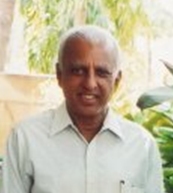 Bangalore based Satish Suri is an avid dance rasika besides being a life member of the Music and Arts Society. |